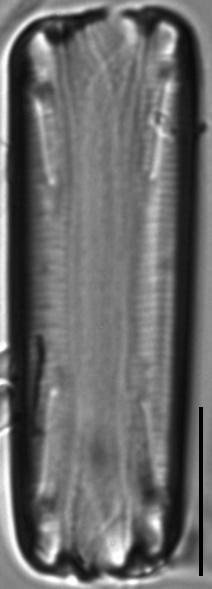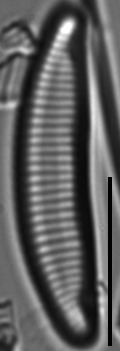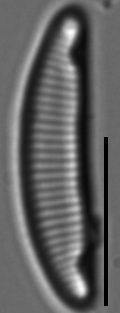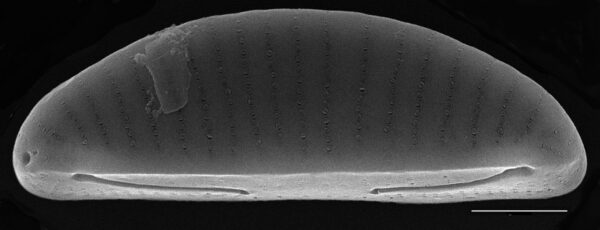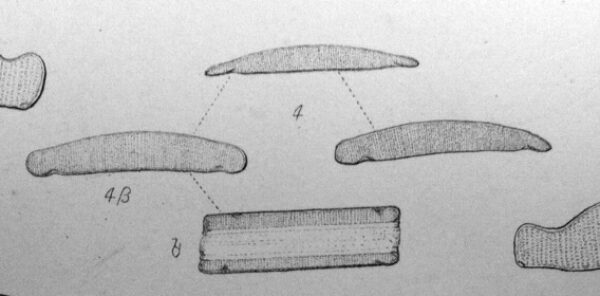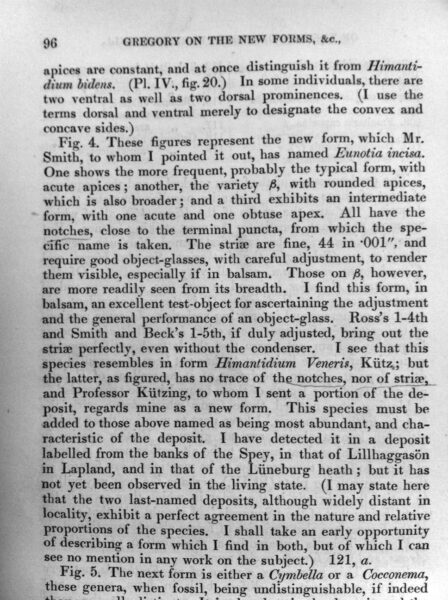Eunotia incisa
-
Category
-
Length Range12-50 µm
-
Width Range2.8-5.0 µm
-
Striae in 10 µm16-21 in the center valve
-
ContributorPaula Furey - Dec 2011
-
ReviewerMarina Potapova - Apr 2012
Identification
Description
The ventral margin is straight in smaller specimens and weakly concave in larger specimens. The dorsal margin is convex. The apices are acutely rounded, appearing 'nose-like' due to the inset position of the helictoglossae. The helictoglossae are set in equidistant from the apices (symmetric to the transapical axis), giving the appearance of an indentation in the LM. One apical rimoportula is present, just dorsal to the center of the apex, and is expressed externally as a round pore. The distal ends of the raphe lie on the valve mantle and the terminal raphe nodules are well set in from the apices. In girdle view the frustules are rectangular to quadratic and the inset helictoglossae are observable.
Several forms and variations in length (L), width (W) and stria density are currently included in the broad concept of E. incisa as presented by Patrick and Reimer (1966; L 15-50 µm, W 4-7 µm, 13-17 stria/10 µm), Krammer and Lange-Bertalot (1991, 13-50 µm, W 4-6 µm, 12-17 stria/10 µm), Siver et al. (2005, L 12-28 µm, W 3-4 µm, 16-17 stria/10 µm; also narrow specimens W 2-2.5 µm), and Furey et al. (2011, 13-50 µm, W 2.8-5.0 µm, 12-17 stria/10 µm). Some of the narrow specimens have been described as new species, such as E. canicula. Specimens that have broader, more rounded apices, such as valves similar in form to Taf. 161, Figs 13-15 in Krammer and Lange-Bertalot (1991) may later be described as new species, but for now should be tracked as a variation in valve form. Lange-Bertalot et al. (2011) have further described new species from Europe, such as E. incisadistans, that share similarities in form (including the inset helictoglossae) that should be compared with the North American flora as taxonomic work on this species continues. Eunotia incisadistans has broader valves with lower stria density.
Autecology
Eunotia incisa is common in acidic, freshwater environments, and can occasionally occur in high abundances.
-
Size Range, µm3
-
Motility
-
Habitat
-
Colony
-
BCG
-
Waterbody
-
Distribution
- Learn more about this
Citations & Links
Citations
Links
-
Index Nominum Algarum
-
North American Diatom Ecological DatabaseNADED ID: 33026
Cite This Page
Furey, P. (2011). Eunotia incisa. In Diatoms of North America. Retrieved February 06, 2025, from https://oldcraft3.diatoms.org/species/eunotia_incisa
Responses
The 15 response plots show an environmental variable (x axis) against the relative abundance (y axis) of Eunotia incisa from all the stream reaches where it was present. Note that the relative abundance scale is the same on each plot. Explanation of each environmental variable and units are as follows:
ELEVATION = stream reach elevation (meters)
STRAHLER = distribution plot of the Strahler Stream Order
SLOPE = stream reach gradient (degrees)
W1_HALL = an index that is a measure of streamside (riparian) human activity that ranges from 0 - 10, with a value of 0 indicating of minimal disturbance to a value of 10 indicating severe disturbance.
PHSTVL = pH measured in a sealed syringe sample (pH units)
log_COND = log concentration of specific conductivity (µS/cm)
log_PTL = log concentration of total phosphorus (µg/L)
log_NO3 = log concentration of nitrate (µeq/L)
log_DOC = log concentration of dissolved organic carbon (mg/L)
log_SIO2 = log concentration of silicon (mg/L)
log_NA = log concentration of sodium (µeq/L)
log_HCO3 = log concentration of the bicarbonate ion (µeq/L)
EMBED = percent of the stream substrate that is embedded by sand and fine sediment
log_TURBIDITY = log of turbidity, a measure of cloudiness of water, in nephelometric turbidity units (NTU).
DISTOT = an index of total human disturbance in the watershed that ranges from 1 - 100, with a value of 0 indicating of minimal disturbance to a value of 100 indicating severe disturbance.
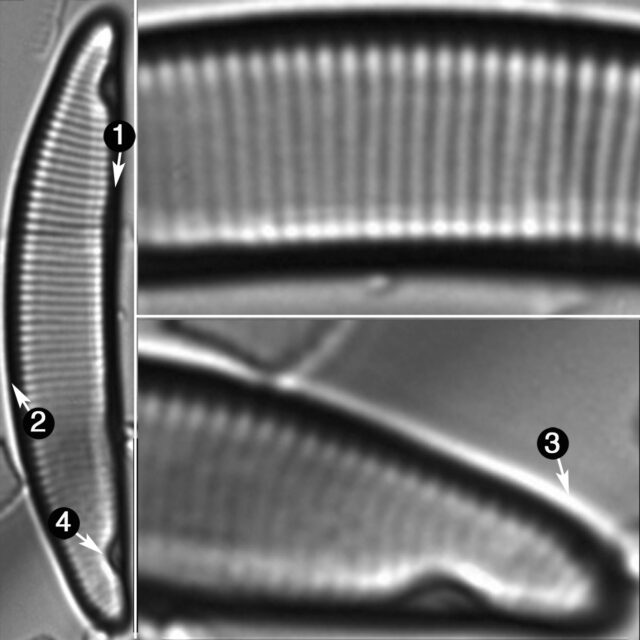
Eunotia incisa
- Ventral margin straight to weakly concave
- Dorsal margin convex
- Apices acutely rounded
- Helictoglossae equidistant from the ends
- Distal raphe on valve mantle
The ventral margin of Eunotia incisa is straight to weakly concave. The dorsal margin is convex. The apices are acutely rounded, appearing 'nose-like' due to the inset position of the helictoglossae which are set in equidistant from the ends (symmetric to the transapical axis). The distal ends of the raphe lie on the valve mantle and...
 Diatoms of North America
Diatoms of North America